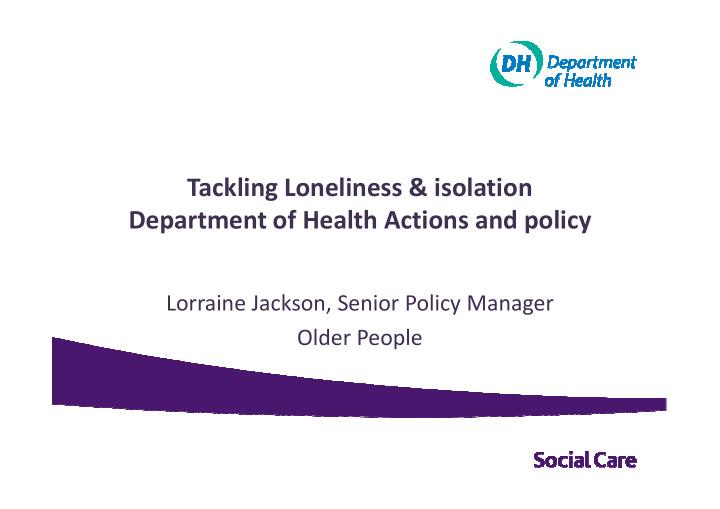



Tackling Loneliness & isolation Department of Health Actions and policy Lorraine Jackson, Senior Policy Manager Older People
The DH context for tackling loneliness & isolation Why should DH have a role in this? We know the risks to health of loneliness, particularly for older people • Older people are core users of health, care and support, their wellbeing is • high priority Loneliness has been a “hidden” problem that was no single organisation’s • responsibility responsibility Leadership was and is needed to tackle this head on and raise awareness • of what can be done Health and care are changing – opportunity to use the new architecture to • focus on outcomes Older people have much to offer that is overlooked and untapped • We are prioritising prevention in health and social care •
What do we mean by Prevention? Prevent or delay a health or social care need becoming more acute, or • developing to require more intensive care over time Primary : Healthy Lifestyle • Secondary: Targeting individuals at risk • Tertiary: minimising disability and loss of independence • Examples: Examples: • • Community based support, befriending – Social contact – Exercise – Information and advice – Falls prevention – Telecare – Telehealth – Reablement – Housing, aids and adaptations –
Older people at home and independent but…. • Keeping out of hospital or residential care is not enough • We must ensure we help people to connect if they want to • Health and wellbeing Boards are a key place for local leadership • “Home can be a lonely place” (Joseph Rowntree Foundation • “Home can be a lonely place” (Joseph Rowntree Foundation Research) • People want to contribute and feel good when they do (WRVS May 2012 “The impact of volunteering on wellbeing in later life”) • Communities need to be age friendly and dementia friendly
The Care and Support White Paper In the White Paper we said: ‘Social isolation is not something that the Government or services can tackle on their own, but we can initiate action to recognise and identify the most isolated people.’ ‘ The voluntary and community sector is uniquely placed to reach socially isolated people and connect them to befriending services and isolated people and connect them to befriending services and other networks of friendship and support.’ ‘The 2013/14 Public Health and Adult Social Care Outcome Frameworks, to be published this autumn, will set out how we will measure the wellbeing of each local area. This will include a focus on the effects of social isolation’
What have we done so far Working with partners including the Campaign to End Loneliness: • – Hosted Loneliness Summit to highlight the issue – Commissioned digital toolkit for the Health and Wellbeing Boards – Developing indicators to measure loneliness Supporting innovation: Supporting innovation: • • – NESTA Ageing Well Challenge Prize – DH Innovation, Excellence & Strategic Development Fund Supporting new service models • – New start up “The Silverline” But lots more to do: Public Health, NHS, Housing…. • Lorraine.jackson@dh.gsi.gov.uk T: 0113254 6242
Recommend
More recommend